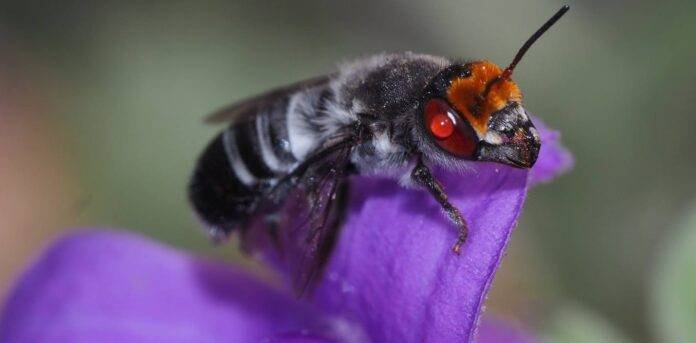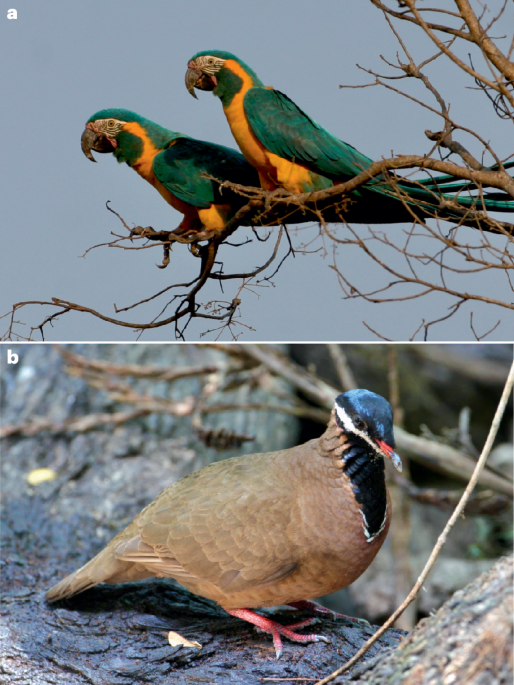Butchart, S. H. et al. Global biodiversity: indicators of recent declines. Science 328(5982), 1164–1168, https://doi.org/10.1126/science.1187512 (2010).
Cowie, R. H., Bouchet, P. & Fontaine, B. The Sixth Mass Extinction: fact, fiction or speculation. Biol. Rev. 97(2), 640–66, https://doi.org/10.1111/brv.12816 (2022).
Kindsvater, H. K. et al. Overcoming the data crisis in biodiversity conservation. Trends Ecol. Evol. 33(9), 676–688, https://doi.org/10.1016/j.tree.2018.06.004 (2018).
Gardner, T. A. et al. The cost‐effectiveness of biodiversity surveys in tropical forests. Ecol. Lett. 11(2), 139–150, https://doi.org/10.1111/j.1461-0248.2007.01133.x (2008).
Marta, S., Lacasella, F., Romano, A. & Ficetola, G. F. Cost-effective spatial sampling designs for field surveys of species distribution. Biodivers. Conserv. 28(11), 2891–2908, https://doi.org/10.1007/s10531-019-01803-x (2019).
Callaghan, C. T., Poore, A. G., Hofmann, M., Roberts, C. J. & Pereira, H. M. Large-bodied birds are over-represented in unstructured citizen science data. Sci. Rep. 11(1), 19073, https://doi.org/10.1038/s41598-021-98584-7 (2021).
Leitão, P. J., Moreira, F. & Osborne, P. E. Effects of geographical data sampling bias on habitat models of species distributions: a case study with steppe birds in southern Portugal. Int. J. Geogr. Inf. Syst. 25(3), 439–454, https://doi.org/10.1080/13658816.2010.531020 (2011).
Meschini, E. & Frugis. S. Atlante degli uccelli nidificanti in Italia. Supplemento Ricerche Biologia della Selvaggina, vol. XX, (1993).
Lardelli, R. et al. Atlante degli uccelli nidificanti in Italia. Edizioni Belvedere. (2022).
Engler, J. O. et al. Avian SDMs: current state, challenges, and opportunities. J. Avian Biol. 48(12), 1483–1504, https://doi.org/10.1111/jav.01248 (2017).
Huntley, B., Collingham, Y. C., Willis, S. G. & Green, R. E. Potential impacts of climatic change on European breeding birds. PloS one 3(1), e1439, https://doi.org/10.1371/journal.pone.0001439 (2008).
Thuiller, W., Guéguen, M., Renaud, J., Karger, D. N. & Zimmermann, N. E. Uncertainty in ensembles of global biodiversity scenarios. Nat. Commun. 10, 1–9, https://doi.org/10.1038/s41467-019-09519-w (2019).
Ferrer Obiol, J. et al. Evolutionarily distinct lineages of a migratory bird of prey show divergent responses to climate change. Nat Commun 16, 3503, https://doi.org/10.1038/s41467-025-58617-5 (2025).
Regos, A. et al. Predicting the future effectiveness of protected areas for bird conservation in Mediterranean ecosystems under climate change and novel fire regime scenarios. Divers. distrib. 22(1), 83–96, https://doi.org/10.1111/ddi.12375 (2016).
Titeux, N. et al. Biodiversity scenarios neglect future land‐use changes. Glob. Chang. Biol. 22(7), 2505–2515, https://doi.org/10.1111/gcb.13272 (2016).
Guisan, A. et al. Predicting species distributions for conservation decisions. Ecol. Lett. 16(12), 1424–1435, https://doi.org/10.1111/ele.12189 (2013).
Rödder, D., Nekum, S., Cord, A. F. & Engler, J. O. Coupling satellite data with species distribution and connectivity models as a tool for environmental management and planning in matrix-sensitive species. Environ. Manage. 58, 130–143, https://doi.org/10.1007/s00267-016-0698-y (2016).
Razgour, O. Beyond species distribution modeling: a landscape genetics approach to investigating range shifts under future climate change. Ecol. Inform. 30, 250–256, https://doi.org/10.1016/j.ecoinf.2015.05.007 (2015).
Giné, G. A. F. & Faria, D. Combining species distribution modeling and field surveys to reappraise the geographic distribution and conservation status of the threatened thin-spined porcupine (Chaetomys subspinosus). PLoS One 13(11), e0207914, https://doi.org/10.1371/journal.pone.0207914 (2018).
Brambilla, M., Bazzi, G. & Ilahiane, L. The effectiveness of species distribution models in predicting local abundance depends on model grain size. Ecology 105(2), e4224, https://doi.org/10.1002/ecy.4224 (2024).
VanDerWal, J., Shoo, L. P., Johnson, C. N. & Williams, S. E. Abundance and the environmental niche: environmental suitability estimated from niche models predicts the upper limit of local abundance. Am. Nat. 174(2), 282–291, https://doi.org/10.1086/600087 (2009).
Van Couwenberghe, R., Collet, C., Pierrat, J. C., Verheyen, K. & Gégout, J. C. Can species distribution models be used to describe plant abundance patterns? Ecography 36(6), 665–674, https://doi.org/10.1111/j.1600-0587.2012.07362.x (2013).
Brambilla, M., Gustin, M., Cento, M., Ilahiane, L. & Celada, C. Predicted effects of climate factors on mountain species are not uniform over different spatial scales. J. Avian Biol., 50(9), https://doi.org/10.1111/jav.02162 (2019).
Van Strien, A. J., Van Swaay, C. A. & Termaat, T. Opportunistic citizen science data of animal species produce reliable estimates of distribution trends if analysed with occupancy models. J. Appl. Ecol. 50(6), 1450–1458, https://doi.org/10.1111/1365-2664.12158 (2013).
Keller, V. et al. European Breeding Bird Atlas 2. Distribution, Abundance and Change. European Bird Census Council & Lynx Edicions, Barcelona. 967 pp. (2020).
Teufelbauer, N. et al. Österreichischer Brutvogelatlas 2013-2018 (1. Aufl.) – 680 S., Wien (Verlag des Naturhistorischen Museum Wien (2023).
Knaus, P. et al. Swiss Breeding Bird Atlas 2013–2016. Distribution and population trends of birds in Switzerland and Liechtenstein. Swiss Ornithological Institute, Sempach (2018).
Medrano, F., Barros, R., Norambuena, H., Matus, R. & Schmitt, F. Atlas de las aves nidificantes de Chile. Red de Observadores de Avesy Vida Silvestre de Chile, Santiago (2018).
Kroeger, S. B. et al. Impacts of roads on bird species richness: A meta-analysis considering road types, habitats and feeding guilds. Sci. Total Environ. 812, 151478, https://doi.org/10.1016/j.scitotenv.2021.151478 (2022).
Bernardino, J. et al. Bird collisions with power lines: State of the art and priority areas for research. Biol. Conserv. 222, 1–13, https://doi.org/10.1016/j.biocon.2018.02.029 (2018).
Assandri, G. et al. Assessing exposure to wind turbines of a migratory raptor through its annual life cycle across continents. Biol. Conserv. 293, 110592, https://doi.org/10.1016/j.biocon.2024.110592 (2024).
HBW & BirdLife International. Handbook of the birds of the world and BirdLife International digital checklist of the birds of the world. Ver. 5. http://datazone.birdlife.org/species/taxonomy (2020).
Baccetti, N., Fracasso, G. & COI, Commissione Ornitologica Italiana. CISO-COI Check-list of Italian birds – 2020. Avocetta, 45(1), https://doi.org/10.30456/AVO.2021_checklist_en (2021).
Brambilla, M. et al. Identifying climate refugia for high‐elevation Alpine birds under current climate warming predictions. Glob. Chang. Biol. 28(14), 4276–4291, https://doi.org/10.1111/gcb.16187 (2022).
RETE RURALE NAZIONALE & LIPU/BirdLife Italy. Farmland Bird Index nazionale e andamenti di popolazione delle specie in Italia nel periodo 2000-2023 [On-line document]. https://www.reterurale.it/en (2024).
Van Eupen, C. et al. The impact of data quality filtering of opportunistic citizen science data on species distribution model performance. Ecol. Modell. 444, 109453, https://doi.org/10.1016/j.ecolmodel.2021.109453 (2021).
Elith, J. et al. A statistical explanation of MaxEnt for ecologists. Divers. Distrib. 17(1), 43–57, https://doi.org/10.1111/j.1472-4642.2010.00725.x (2011).
Phillips, S. J., Anderson, R. P., Dudík, M., Schapire, R. E. & Blair, M. E. Opening the black box: An open‐source release of Maxent. Ecography 40(7), 887–893, https://doi.org/10.1111/ecog.03049 (2017).
Grimmett, L., Whitsed, R. & Horta, A. Presence-only species distribution models are sensitive to sample prevalence: Evaluating models using spatial prediction stability and accuracy metrics. Ecol. Modell. 431, 109194, https://doi.org/10.1016/j.ecolmodel.2020.109194 (2020).
Lissovsky, A. A. & Dudov, S. V. Species-distribution modeling: advantages and limitations of its application. 2. MaxEnt. Biol. Bull. Rev. 11(3), 265–275, https://doi.org/10.1134/S2079086421030087 (2021).
Yackulic, C. B. et al. Presence‐only modelling using MAXENT: when can we trust the inferences? Methods Ecol. Evol. 4(3), 236–243, https://doi.org/10.1111/2041-210x.12004 (2013).
Cobos, M. E., Peterson, A. T., Osorio-Olvera, L. & Jiménez-García, D. An exhaustive analysis of heuristic methods for variable selection in ecological niche modeling and species distribution modeling. Ecol. Inform. 53, 100983, https://doi.org/10.1016/j.ecoinf.2019.100983 (2019).
Muscarella, R. et al. ENM eval: An R package for conducting spatially independent evaluations and estimating optimal model complexity for Maxent ecological niche models. Methods Ecol. Evol. 5(11), 1198–1205, https://doi.org/10.1111/2041-210X.12261 (2014).
Vollering, J., Halvorsen, R., Auestad, I. & Rydgren, K. Bunching up the background betters bias in species distribution models. Ecography 42(10), 1717–1727, https://doi.org/10.1111/ecog.04503 (2019).
Feng, X., Park, D. S., Liang, Y., Pandey, R. & Papeş, M. Collinearity in ecological niche modeling: Confusions and challenges. Ecol. Evol. 9(18), 10365–10376, https://doi.org/10.1002/ece3.5555 (2019).
Holland, J. D., Bert, D. G. & Fahrig, L. Determining the spatial scale of species’ response to habitat. Biosci. 54(3), 227–233, https://doi.org/10.1641/0006-3568(2004)054[0227:DTSSOS]2.0.CO;2 (2004).
Bas, J. M., Pons, P. & Gómez, C. Home range and territory of the Sardinian Warbler Sylvia melanocephala in Mediterranean shrubland. Bird Study 52(2), 137–144, https://doi.org/10.1080/00063650509461383 (2005).
Pfeiffer, T. & Meyburg, B. U. GPS tracking of Red Kites (Milvus milvus) reveals fledgling number is negatively correlated with home range size. J. Ornithol. 156, 963–975, https://doi.org/10.1007/s10336-015-1230-5 (2015).
Fourcade, Y., Engler, J. O., Rödder, D. & Secondi, J. Mapping species distributions with MAXENT using a geographically biased sample of presence data: a performance assessment of methods for correcting sampling bias. PloS one 9(5), e97122, https://doi.org/10.1371/journal.pone.0097122 (2014).
Karger, D. et al. Climatologies at high resolution for the earth’s land surface areas. Sci. Data 4(1), 1–20, https://doi.org/10.1038/sdata.2017.122 (2017).
Ceresa, F., Kranebitter, P., Monrós, J. S., Rizzolli, F. & Brambilla, M. Disentangling direct and indirect effects of local temperature on abundance of mountain birds and implications for understanding global change impacts. PeerJ 9, e12560, https://doi.org/10.7717/peerj.12560 (2021).
Hijmans, R. J., Cameron, S. E., Parra, J. L., Jones, P. G. & Jarvis, A. Very high resolution interpolated climate surfaces for global land areas. Int. J. Climatol. 25(15), 1965–1978, https://doi.org/10.1002/joc.1276 (2005).
Xu, T. & Hutchinson, M. F. New developments and applications in the ANUCLIM spatial climatic and bioclimatic modelling package. Environ. Model. Softw. 40, 267–279, https://doi.org/10.1016/j.envsoft.2012.10.003 (2013).
Neteler, M., Bowman, M. H., Landa, M. & Metz, M. GRASS GIS: A multi-purpose open source GIS. Environ. Model. Softw. 31, 124–130, https://doi.org/10.1016/j.envsoft.2011.11.014 (2012).
European Environment Agency. Corine Land Cover 2012 [On-line document]. https://doi.org/10.2909/a84ae124-c5c5-4577-8e10-511bfe55cc0d (2016).
Valerio, F. et al. GEE_xtract: High-quality remote sensing data preparation and extraction for multiple spatio-temporal ecological scaling. Ecol. Inform. 80, 102502, https://doi.org/10.1016/j.ecoinf.2024.102502 (2024).
Morales, N. S., Fernández, I. C. & Baca-González, V. MaxEnt’s parameter configuration and small samples: are we paying attention to recommendations? A systematic review. PeerJ 5, e3093, https://doi.org/10.7717/peerj.3093 (2017).
Brambilla, M. et al. Potential distribution of a climate sensitive species, the White-winged Snowfinch Montifringilla nivalis in Europe. Bird Conserv. Int. 30(4), 522–532, https://doi.org/10.1017/S0959270920000027 (2020).
Bartoń, K. MuMIn: Multi-model inference (1.43. 17). Vienna, Austria: The R Foundation for Statistical Computing. https://cran.r-project.org/package=MuMIn (2020).
Burnham, K. P. & Anderson, D. R. Model selection and multimodel inference. A practical information-theoretic approach. Second. NY: Springer-Verlag 63(2020), 10, https://doi.org/10.1007/b97636 (2004).
Dormann, C. F. et al. Collinearity: a review of methods to deal with it and a simulation study evaluating their performance. Ecography 36(1), 27–46, https://doi.org/10.1111/j.1600-0587.2012.07348.x (2013).
Ilahiane, L. Replication data for: “High-resolution habitat suitability maps for all widespread Italian breeding bird species”. UNIMI Dataverse https://doi.org/10.13130/RD_UNIMI/LUC3K6 (2024).
Liu, C., White, M. & Newell, G. Selecting thresholds for the prediction of species occurrence with presence‐only data. J. Biogeogr. 40(4), 778–789, https://doi.org/10.1111/jbi.12058 (2013).
Vaughan, I. P. & Ormerod, S. J. The continuing challenges of testing species distribution models. J. Appl. Ecol. 42(4), 720–730, https://doi.org/10.1111/j.1365-2664.2005.01052.x (2005).
Fielding, A. H. & Bell, J. F. A review of methods for the assessment of prediction errors in conservation presence/absence models. Environ. Conserv. 24(1), 38–49, https://www.jstor.org/stable/44519240 (1997).
Lobo, J. M., Jiménez‐Valverde, A. & Real, R. AUC: a misleading measure of the performance of predictive distribution models. Glob. Ecol. Biogeogr. 17(2), 145–151, https://doi.org/10.1111/j.1466-8238.2007.00358.x (2008).
Allouche, O., Tsoar, A. & Kadmon, R. Assessing the accuracy of species distribution models: prevalence, kappa and the true skill statistic (TSS). J. Appl. Ecol. 43(6), 1223–1232, https://doi.org/10.1111/j.1365-2664.2006.01214.x (2006).
Elith, J. & Leathwick, J. R. Species distribution models: ecological explanation and prediction across space and time. Annu. Rev. Ecol. Evol. Syst. 40(1), 677–697, https://doi.org/10.1146/annurev.ecolsys.110308.120159 (2009).
Guillera‐Arroita, G., Lahoz‐Monfort, J. J. & Elith, J. Maxent is not a presence–absence method: a comment on Thibaud et al. Methods Ecol. Evol. 5(11), 1192–1197, https://doi.org/10.1111/2041-210X.12252 (2014).
Dalpasso, A. et al. High nature value farmlands to identify crucial agroecosystems for multitaxa conservation. Biol. Conserv. https://doi.org/10.1016/j.biocon.2025.111094 (2025).
Jedlikowski, J., Chibowski, P., Karasek, T. & Brambilla, M. Multi-scale habitat selection in highly territorial bird species: exploring the contribution of nest, territory and landscape levels to site choice in breeding rallids (Aves: Rallidae). Acta Oecol. 73, 10–20, https://doi.org/10.1016/j.actao.2016.02.003 (2016).
Brambilla, M. Species data with variables for the paper “Identifying climate refugia for high-elevation Alpine birds under current climate warming predictions”. UNIMI Dataverse https://doi.org/10.13130/RD_UNIMI/ARAI8C (2022).






